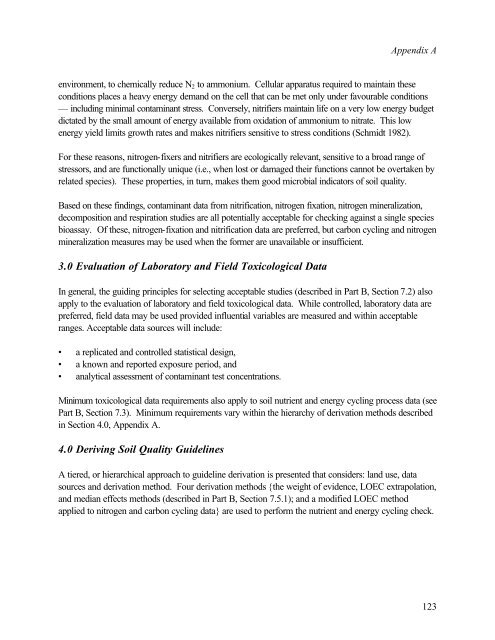Protocol for the Derivation of Environmental and Human ... - CCME
Protocol for the Derivation of Environmental and Human ... - CCME
Protocol for the Derivation of Environmental and Human ... - CCME
You also want an ePaper? Increase the reach of your titles
YUMPU automatically turns print PDFs into web optimized ePapers that Google loves.
Appendix A<br />
environment, to chemically reduce N 2 to ammonium. Cellular apparatus required to maintain <strong>the</strong>se<br />
conditions places a heavy energy dem<strong>and</strong> on <strong>the</strong> cell that can be met only under favourable conditions<br />
— including minimal contaminant stress. Conversely, nitrifiers maintain life on a very low energy budget<br />
dictated by <strong>the</strong> small amount <strong>of</strong> energy available from oxidation <strong>of</strong> ammonium to nitrate. This low<br />
energy yield limits growth rates <strong>and</strong> makes nitrifiers sensitive to stress conditions (Schmidt 1982).<br />
For <strong>the</strong>se reasons, nitrogen-fixers <strong>and</strong> nitrifiers are ecologically relevant, sensitive to a broad range <strong>of</strong><br />
stressors, <strong>and</strong> are functionally unique (i.e., when lost or damaged <strong>the</strong>ir functions cannot be overtaken by<br />
related species). These properties, in turn, makes <strong>the</strong>m good microbial indicators <strong>of</strong> soil quality.<br />
Based on <strong>the</strong>se findings, contaminant data from nitrification, nitrogen fixation, nitrogen mineralization,<br />
decomposition <strong>and</strong> respiration studies are all potentially acceptable <strong>for</strong> checking against a single species<br />
bioassay. Of <strong>the</strong>se, nitrogen-fixation <strong>and</strong> nitrification data are preferred, but carbon cycling <strong>and</strong> nitrogen<br />
mineralization measures may be used when <strong>the</strong> <strong>for</strong>mer are unavailable or insufficient.<br />
3.0 Evaluation <strong>of</strong> Laboratory <strong>and</strong> Field Toxicological Data<br />
In general, <strong>the</strong> guiding principles <strong>for</strong> selecting acceptable studies (described in Part B, Section 7.2) also<br />
apply to <strong>the</strong> evaluation <strong>of</strong> laboratory <strong>and</strong> field toxicological data. While controlled, laboratory data are<br />
preferred, field data may be used provided influential variables are measured <strong>and</strong> within acceptable<br />
ranges. Acceptable data sources will include:<br />
• a replicated <strong>and</strong> controlled statistical design,<br />
• a known <strong>and</strong> reported exposure period, <strong>and</strong><br />
• analytical assessment <strong>of</strong> contaminant test concentrations.<br />
Minimum toxicological data requirements also apply to soil nutrient <strong>and</strong> energy cycling process data (see<br />
Part B, Section 7.3). Minimum requirements vary within <strong>the</strong> hierarchy <strong>of</strong> derivation methods described<br />
in Section 4.0, Appendix A.<br />
4.0 Deriving Soil Quality Guidelines<br />
A tiered, or hierarchical approach to guideline derivation is presented that considers: l<strong>and</strong> use, data<br />
sources <strong>and</strong> derivation method. Four derivation methods {<strong>the</strong> weight <strong>of</strong> evidence, LOEC extrapolation,<br />
<strong>and</strong> median effects methods (described in Part B, Section 7.5.1); <strong>and</strong> a modified LOEC method<br />
applied to nitrogen <strong>and</strong> carbon cycling data} are used to per<strong>for</strong>m <strong>the</strong> nutrient <strong>and</strong> energy cycling check.<br />
123
















